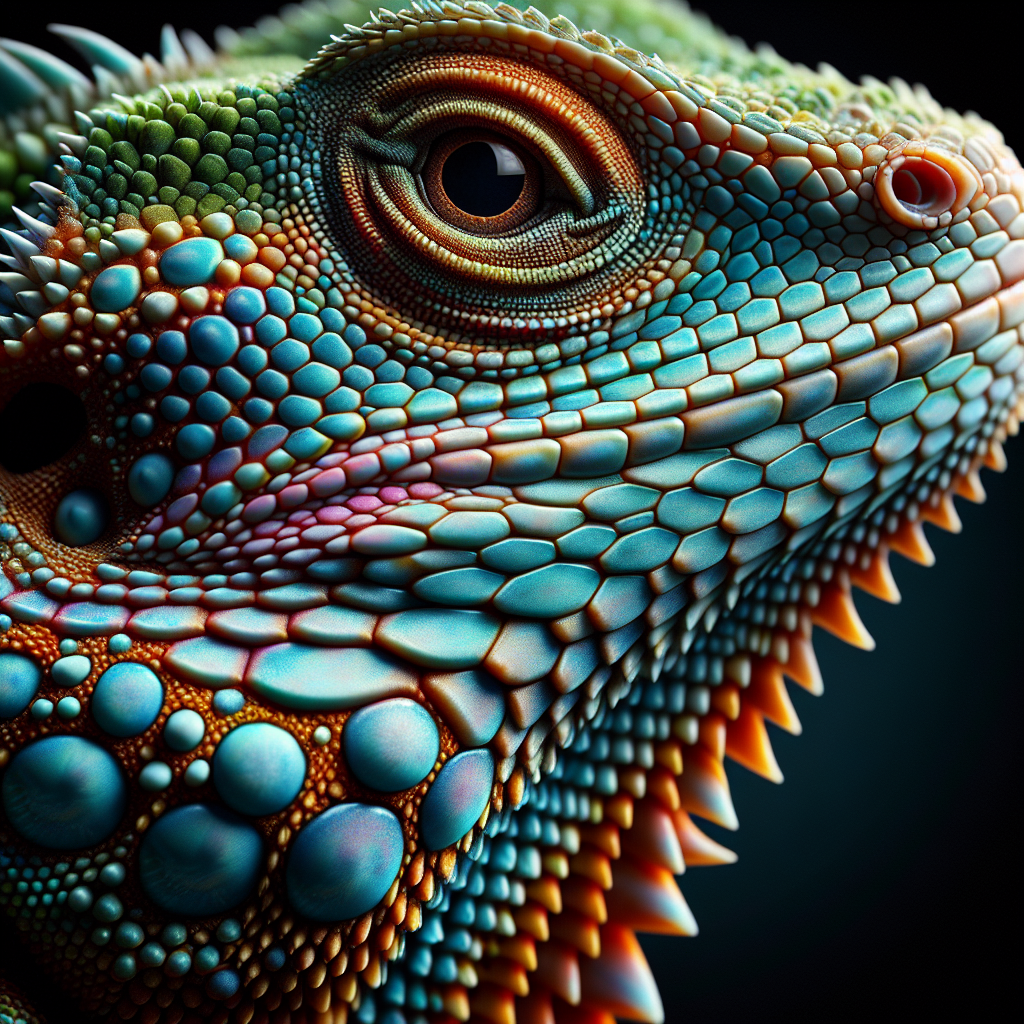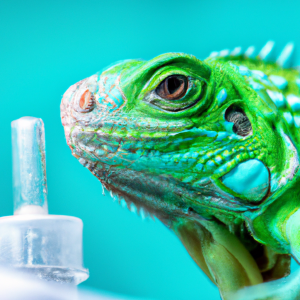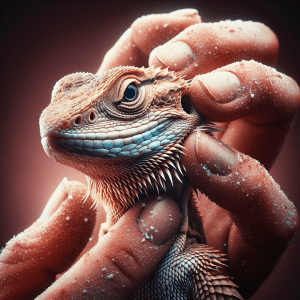Introduction to Signs of Stress in Lizards
Have you ever noticed your pet lizard acting a bit off lately? Maybe they seem more withdrawn or agitated than usual. Well, that could be a sign that your scaly friend is feeling stressed. And just like us, lizards can experience stress too!
In the wild, lizards have to constantly be on the lookout for predators, find food, and navigate their environment. But when they’re kept as pets, their needs are a bit different. Sometimes, the conditions in their enclosure or how they’re being handled can cause them to feel anxious or overwhelmed.
It’s crucial to understand the behavior of stressed lizards so we can help them feel more at ease in their surroundings. Lizards may exhibit subtle signs of stress that are easy to miss if you’re not paying close attention. For example, they might startle easily, avoid interaction, or even change their eating habits.
Recognizing these signs early on can make a big difference in your lizard’s well-being. By understanding what triggers stress in lizards, we can take steps to minimize those factors and create a more comfortable environment for our scaly companions. Remember, a happy and stress-free lizard is a healthy lizard!
So, the next time you observe your pet lizard behaving differently, take a moment to consider if they might be feeling stressed. With a little bit of knowledge and care, you can help your lizard thrive in their home environment. Stay tuned as we dive deeper into the common causes of stress in pet lizards and how to address them effectively.
Understanding the Behavior of Stressed Lizards
Understanding the Behavior of Stressed Lizards is crucial when it comes to caring for these fascinating reptiles. You see, just like us, lizards can also experience stress from various factors in their environment. It’s like that time when we went on a road trip, and you got really anxious because we took a wrong turn, remember? Well, lizards can also show signs of stress through their behaviors.
When a lizard is stressed, you may notice changes in how they act. They might become more agitated, hide more often, or even display aggressive behavior. It’s like how you tend to fidget and become restless when you’re feeling stressed out. Lizards communicate their stress through their actions, so it’s essential to observe and understand these behaviors to provide them with the care they need.
Did you know that some lizards exhibit color changes when they are stressed? Yes, it’s true! Just like a chameleon changing its color to blend in with its surroundings, some lizards may show darker or lighter hues when they are under stress. It’s a fascinating way for them to express their emotions visually.
Understanding the behavior of stressed lizards can help you identify when your pet is feeling uneasy or uncomfortable. By paying attention to their actions and reactions, you can create a more soothing environment for them and help alleviate their stress. So, the next time you notice your lizard behaving differently, take a moment to assess their surroundings and see if there are any factors causing them distress. Your lizard will thank you for it!
Common Causes of Stress in Pet Lizards
Have you ever noticed your pet lizard acting a little off? It might be experiencing stress. Stress in lizards is more common than you might think, and understanding the common causes can help you better care for your scaly friend.
Let me share an interesting fact with you: Did you know that changes in the lizard’s environment can often be a major cause of stress? Whether it’s a sudden change in temperature, lighting, or even the presence of other pets, these factors can all contribute to your lizard feeling stressed out.
This brings us to the common causes of stress in pet lizards. While each lizard is unique, some factors are known to trigger stress universally. From improper handling and inadequate living conditions to loud noises and lack of hiding spots, there are several aspects of a lizard’s environment that can lead to stress.
Understanding these common stressors is crucial for providing a comfortable and safe habitat for your lizard. By recognizing and addressing these triggers, you can help reduce your pet’s stress levels and promote its overall well-being. Remember, a happy lizard is a healthy lizard!
So, the next time you notice your lizard behaving unusually, take a moment to assess its environment and daily routine. By identifying and addressing potential stressors, you can create a harmonious living space for your scaly companion.
Physical Signs of Stress in Lizards
Have you ever noticed your pet lizard displaying some unusual behaviors? It could be a sign that your scaly friend is experiencing stress. Let’s dive into the physical signs of stress in lizards!
When my bearded dragon, Spike, started shedding excessively and showing a lack of appetite, I was initially puzzled. Little did I know that these were key physical indicators of stress in lizards. Understanding these signs can help us identify when our reptile companions need extra care and attention.
Did you know that changes in skin color and patterns can also signal stress in lizards? Keep an eye out for any unusual color variations or dark patches on your lizard’s skin, as they could be a red flag for stress levels. Monitoring these physical cues can provide valuable insights into your lizard’s well-being.
Recognizing physical signs of stress is essential for proactive lizard care. By addressing these symptoms promptly, we can help alleviate stress and create a healthier environment for our scaly pals. Remember, a happy and stress-free lizard is a thriving lizard!
So, the next time you observe any physical changes in your pet lizard, take a closer look and consider whether stress could be the underlying cause. Your attention to these details can make a significant difference in keeping your lizard content and comfortable in its habitat.
Behavioral Signs of Stress in Lizards
Have you ever noticed your lizard acting a bit off lately? It’s important to pay attention to their behavior because it could be a sign that they are stressed out. Let’s dive into the behavioral signs of stress in lizards and how to interpret them.
One interesting fact about lizards is that they exhibit various behaviors when they are feeling stressed. For example, if you notice your lizard pacing back and forth in its enclosure, repeatedly glass surfing, or showing aggressive behavior, these could all be indications that your scaly friend is under stress.
Understanding these behaviors is crucial in helping your lizard feel more at ease in their environment. By recognizing these signs early on, you can take steps to reduce stress and create a more comfortable space for your pet.
To address behavioral signs of stress in lizards, it’s essential to observe your lizard’s actions regularly. By spending time with your pet and paying attention to their body language, you can pick up on subtle cues that may reveal their stress levels.
Incorporating enrichments like hiding spots, climbing structures, and proper temperature gradients in their habitat can also help reduce stress and promote natural behaviors. Additionally, providing a consistent feeding schedule and minimizing disturbances in their environment can contribute to a calmer and happier lizard.
Remember, each lizard is unique, and what works for one may not work for another. It’s all about trial and error and finding what helps your lizard feel most comfortable and secure in their space.
So, the next time you notice your lizard displaying unusual behaviors, take a moment to observe and assess their surroundings. By understanding and addressing the behavioral signs of stress in lizards, you can ensure that your scaly companion stays healthy and content.
How to Reduce Stress in Lizards
Creating a stress-free environment for your lizard is crucial to ensuring their well-being and happiness. When I first got my bearded dragon, I had to learn the hard way that even small changes in their habitat can lead to stress. It’s like walking on eggshells sometimes, trying to make sure everything is just right for them.
One interesting fact about reducing stress in lizards is that environmental factors play a significant role. Did you know that lizards are highly sensitive to changes in temperature, lighting, and humidity? These factors can greatly impact their stress levels. For example, sudden fluctuations in temperature can cause stress, so it’s essential to maintain a stable environment for your scaly friend.
So, how can you create a stress-free habitat for your lizard? One practical tip is to provide plenty of hiding spots and climbing opportunities in their enclosure. Lizards, like most reptiles, crave security and the ability to retreat to a safe space when they feel overwhelmed. By adding branches, rocks, and caves to their habitat, you can help reduce their stress levels and promote natural behaviors.
Have you ever thought about the broader significance of reducing stress in lizards? Ensuring your pet is comfortable and stress-free not only improves their quality of life but also contributes to their overall health. Stress can weaken their immune system, making them more susceptible to illnesses. By taking proactive steps to minimize stress, you’re ultimately helping your lizard lead a longer and happier life.
Remember, creating a stress-free environment for your lizard is a continuous process of observation, adjustment, and care. By understanding their needs and providing a safe and comfortable habitat, you can help your scaly companion thrive and enjoy a stress-free life.
Creating a Stress-Free Environment for Your Lizard
Creating a stress-free environment for your lizard is crucial for their well-being. You want them to feel safe and comfortable in their habitat, just like we want to feel cozy in our homes. Imagine if your living room suddenly had bright lights flashing all the time or loud noises blaring in the background – you’d feel stressed too, right? Well, lizards are no different!
One practical tip to make your lizard’s environment stress-free is to provide plenty of hiding spots. Just like we retreat to our bedrooms for some peace and quiet, lizards need their safe spaces too. Adding rocks, plants, or artificial caves in their tank gives them places to hide and feel secure. It’s like having a cozy blanket fort for your pet lizard!
Another essential aspect is maintaining the right temperature and humidity levels in their habitat. Lizards are cold-blooded creatures, so they rely on external sources of warmth to regulate their body temperature. Ensuring that their tank is appropriately heated and has a humid environment mimics their natural habitat, reducing stress and promoting good health.
It’s fascinating how small changes in their environment can make a big difference in a lizard’s stress levels. Just like how a cluttered room can make us feel overwhelmed, a cluttered tank can stress out your lizard. Keeping their living space clean and well-organized not only reduces stress but also makes it easier for you to monitor their behavior and health.
Remember, a stress-free lizard is a happy lizard. By creating a calm and comfortable environment for your scaly friend, you’re not just reducing their stress levels – you’re also ensuring they lead a healthy and content life. So, let’s make their habitat a lizard paradise where they can bask under their heat lamp and lounge in peace, just like royalty in their castle!
Tips for Handling a Stressed Lizard
Let me tell you about handling a stressed lizard. It’s crucial to approach them gently and with patience. Imagine you’re having a bad day, and suddenly someone tries to pick you up without warning – not the best feeling, right? Well, lizards feel the same way when they’re stressed out. So, when handling a stressed lizard, it’s important to do so calmly and avoid sudden movements.
One practical tip to remember is to always support their body properly. Lizards are delicate creatures, and picking them up incorrectly can cause them even more stress. Make sure to fully support their body and avoid grabbing them too tightly. It’s all about making them feel safe and secure in your hands.
You know, I once tried to handle my friend’s stressed-out gecko without being mindful of its state, and let’s just say it didn’t end well. The gecko got even more agitated, and it was quite a challenge to calm it down. That experience taught me the importance of understanding and respecting a lizard’s boundaries when they are stressed.
When handling a stressed lizard, it’s essential to be observant of their body language. Are they puffing up, hissing, or trying to escape your grasp? These are signs that they are feeling overwhelmed and need their space. Always pay attention to these cues and adjust your approach accordingly.
Remember, handling a stressed lizard requires patience and empathy. By respecting their boundaries, providing a calm environment, and supporting their body properly, you can help alleviate their stress and build a trusting relationship with your reptile companion.
Seeking Veterinary Care for Stressed Lizards
Imagine you’re explaining IX. to a friend (400 words). Engage in a lively conversation as if you were talking in person, keeping the tone informal yet informative (400 words).
Veterinary care for stressed lizards is crucial, my friend. Remember that time when my bearded dragon, Spike, was acting all weird and sluggish? I was so worried about him, but a trip to the vet really helped. It turned out he was stressed due to changes in his environment, poor diet, and lack of proper lighting. The vet gave me some great advice on how to make Spike feel better.
You know, seeking veterinary care for a stressed lizard is not just about physical health; it’s also about their mental well-being. Lizards can’t talk to us, so it’s essential to pay attention to their behavior and any unusual signs. A vet specializing in reptiles can conduct a thorough examination to diagnose the underlying cause of stress in your scaly friend.
It’s fascinating to learn that veterinarians have specialized knowledge and experience in treating reptiles like lizards. They understand the unique physiology and behavior of these creatures, which is so important when it comes to diagnosing and treating stress-related issues. Plus, they can offer valuable insights and recommendations on how to improve your lizard’s living conditions and overall quality of life.
You might wonder, “When should I take my lizard to the vet for stress?” Well, if you notice persistent signs of stress despite your efforts to alleviate them, it’s time to seek professional help. Don’t wait until your lizard’s health deteriorates further; early intervention can prevent serious complications and ensure a happy, healthy pet.
So, next time you notice your lizard exhibiting signs of stress that you can’t resolve on your own, don’t hesitate to schedule a visit to the vet. Your scaly companion deserves the best care possible, and a knowledgeable reptile veterinarian can provide just that. Remember, a little proactive care goes a long way in keeping your lizard content and thriving.
Conclusion and Recap of Key Points
Have you ever wondered how to handle a stressed lizard? It’s crucial to know the right approach to help your scaly friend feel comfortable and safe. When a lizard is stressed, it can exhibit various behaviors that signal its discomfort. From changes in eating habits to excessive hiding, these signs can be quite telling.
One practical tip to keep in mind when dealing with a stressed lizard is to create a stress-free environment. Just like humans, lizards thrive in a calm and comfortable setting. By providing your lizard with appropriate housing, temperature, and lighting, you can help reduce stress levels significantly. Remember, a happy lizard is a healthy lizard!
It’s essential to observe your lizard’s behavior closely to identify any signs of stress. An interesting fact to note is that lizards are highly sensitive creatures and can easily get stressed by changes in their environment. By understanding your lizard’s preferences and habits, you can create an environment that promotes their well-being.
Another important aspect to consider is seeking veterinary care when necessary. If you notice persistent signs of stress in your lizard despite your best efforts, consulting a reptile veterinarian can provide valuable insights and guidance on how to address the issue effectively. Your lizard’s health and happiness are top priorities, so don’t hesitate to seek professional help if needed.
In conclusion, handling a stressed lizard requires patience, observation, and a proactive approach to create a nurturing environment. By implementing practical tips and being attentive to your lizard’s needs, you can help alleviate stress and ensure a harmonious relationship with your scaly companion.




